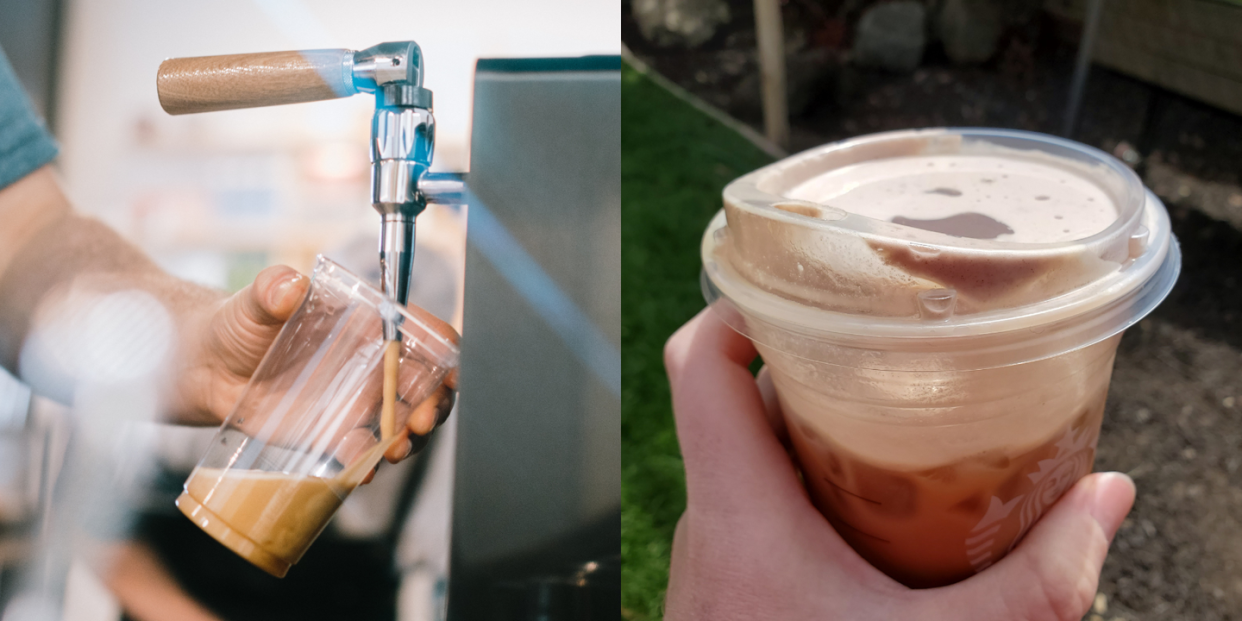Here's Why Cold Brew Is More Expensive Than Iced Coffee

The temperature is climbing higher and higher as we approach summer. But since our caffeine cravings are year-round, coffee lovers everywhere are swapping out their piping hot brews for warm weather-friendly alternatives.
If you frequent your local coffee shop, you’ve probably seen cold brew listed on the menu. Compared to the classic iced coffee, cold brew is newer to the scene—but its popularity is on the rise.
According to market research firm Statista, cold brew’s market value has tripled over the past five years and is projected to become a nearly billion dollar industry by 2025.
Several brands have been hopping on the cold brew band wagon. You can find cold brew on tap at Starbucks locations nationwide and buy bottles of the concentrated beverage to dilute at home.
But isn’t cold brew just iced coffee? The short answer is yes and no. Cold brew is coffee that’s typically served over ice, but the method of preparation and its flavor profile make this drink distinct.
We’re breaking down the differences between iced coffee and cold brew so you’ll know exactly what you’re ordering and impress everyone with your coffee knowledge.
Iced Coffee
The process of making iced coffee is relatively self-explanatory: it’s hot coffee that’s subsequently cooled and served over ice. The process of cooling varies between allowing it to chill slowly in the fridge to diluting the hot coffee with ice.
If you’re worried that your iced coffee will be watery, you shouldn’t be. Many cafés (Starbucks included) brew their coffee at double strength to compensate for the dilution.
Making iced coffee is a relatively quick process and can be made with just about any brewing method. One common preparation is referred to as Japanese flash brew, where you replace some of the water with ice in the coffee pot. The brewed coffee rapidly cools so you can enjoy a cold cup in minutes.
Beyond how fast you can make iced coffee, the method also provides a special flavor profile that you can only get by using hot water. The heat brings out delicate floral notes and a strong intensity.
Cold Brew
Even though cold brew is a more recent trend, the technique dates back centuries. One of the oldest documented records of cold brew coffee can be traced to Japan in the 1600s.
Unlike the standard coffee brewing method that extracts the flavor of the beans with hot water, cold brew is made exclusively with cold water. This process takes much longer than making hot coffee. Instead, cold brew sits in the fridge anywhere from 12 to 24 hours.
Then, the coffee grounds are strained, leaving you with a chilled brew that’s ready to drink. The process is pretty hands off, but requires a lot of patience.
Besides a different technique, cold brewing coffee also has a different flavor. The use of cold water highlights the naturally sweet and mild taste of the coffee beans. Making coffee with hot water, on the other hand, brings out some bitterness and acidity.
Another quality that makes cold brew distinct is the caffeine levels. Cold brew requires almost twice as much coffee grounds as regular coffee, so each sip gives you a much stronger buzz.
You could simply enjoy cold brew over ice just as you would iced coffee. However, many artisanal coffee shops up the ante by offering nitro cold brew. True to its name, this version infuses nitrogen gas into cold brew and is served from a tap. The method adds tons of tiny nitrogen bubbles to your brew, which adds some sweetness and creates a velvety and creamy texture—almost as if you added steamed milk.
The amount of coffee, time, and equipment required to make cold brew typically tacks on a premium. Some cups can cost upwards of $6, but coffee fanatics firmly believe that the flavor is worth the price.
Do you prefer iced coffee or cold brew? Let us know in the comments.
You Might Also Like

